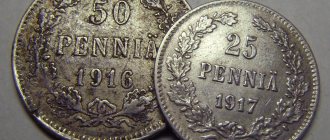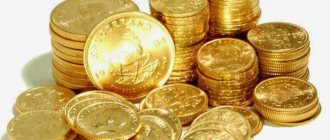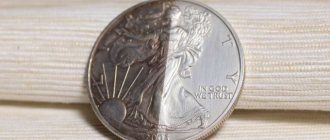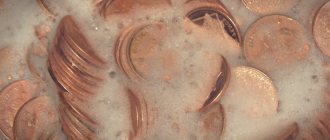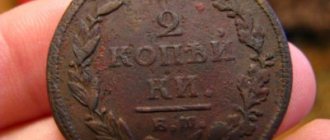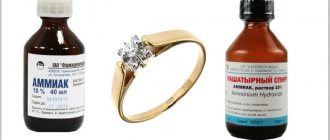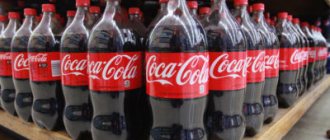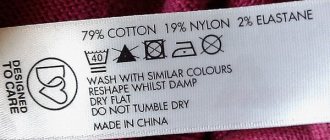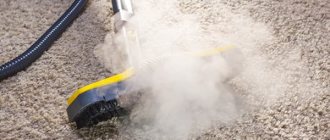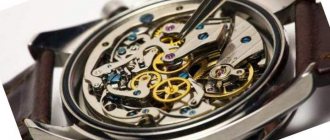Commemorative coins of modern Russia with a face value of 10 rubles, even when stored in a transparent sealed capsule, tend to lose their original shine. Dozens of new designs, known from the “Cities of Military Glory” series and single copies: “50 years of the first manned space flight” and “Official emblem of the 65th anniversary of the Victory,” are darkening especially quickly. With bimetallic ones the situation is better, but they should also be taken care of. Cleaning 10 ruble coins at home should be treated with caution, since many chemicals and acids lead to a sharp decrease in the quality of the metal. The result is scratches visible to the naked eye, loss of shine and completely missing minted elements. Up-to-date information on the most gentle ways to clean coins will help eliminate such errors.
Regular toothpaste
The simplest and relatively safe way to clean 10 ruble coins is to use ordinary toothpaste
. Moreover, the cheapest brand New Pearl or Colgate without additives in the form of crystals will do. The brush should be soft and hard to reduce the likelihood of scratches, and be sure not to bend. Otherwise, the process will drag on for a long time.
2-3 drops of paste are enough for one coin. Cleaning should begin under running warm water or in a small saucer of heated bottled drinking water. Under the tap, in 90% of cases it is chlorinated, which can later affect the quality. Dozens of plated ones begin to shine immediately. On bimetallic coins, the rim first becomes light, then the central part.
This method is excellent for cleaning coins from blackness and small deposits. Does not protect against rust and corrosion. When stored in a capsule or album, the shine remains for 4-5 months.
How to clean a coin at home
The question of cleaning coins arises for many numismatists. It happens that a collection specimen comes across from circulation or the coin was simply stored in unsuitable conditions and was often handled with hands without gloves. If surface contamination can be washed off with soapy water, then with ingrained dirt and oxidation the situation is more complicated.
I had dirty, sometimes oxidized bimetallic coins lying around my house and I wanted to clean them. There are many ways to clean coins on the Internet. I read various materials, opinions on forums, watched videos and ultimately chose the cleaning method using vinegar.
One of the dirty coins from circulation that I cleaned as an example.
Salt is poured into a jar or plastic container, vinegar is poured, diluted with water. The result is a dilute solution of chloride in acetic acid. The mixture will have some of the properties of hydrochloric acid, only very dilute.
Choose the proportion yourself. The more vinegar, the faster the coin is cleaned (in pure vinegar it was cleared of dirt in 5-10 minutes, and in vinegar essence literally before my eyes), the more water, the more delicate the effect on the coin.
My salt had additives and was not completely dissolved, so I didn’t have to turn over the coins. She created a porous cushion and the vinegar affected both sides of the coin. Depending on the company that produces salt, the speed of its dissolution in water varies. In the photo below, it didn’t completely dissolve for days, and then I tried another one, it dissolved very quickly.
A couple of years ago they started adding additives to salt and now almost all manufacturers do this. Therefore, it is no longer salty and it is necessary to put more of it in dishes, which means more income for the manufacturer. Consumption goes faster and initially the volume of production increases due to additives.
A plastic ice cream container with a lid. I put a dozen and a half coins here at a time.
I usually leave the coins overnight or put them in a vinegar solution in the morning and check them in the evening. I determine the concentration of vinegar by smell, so that it doesn’t smell too strong. In difficult cases, when there is strong oxidation, I leave the coin again for 10-12 hours and then see the result.
Often, after being in vinegar, a pink coating forms on the yellow brass rim of the coin, and rich red spots appear in place of the black spots of oxidation.
The coin brightened, but brown spots appeared on the brass. This is not dirt - copper came out.
After rinsing the coin with water, wipe it dry with a paper napkin or soft cloth. To remove the copper that has come out, I smear the reddened areas with iodine and wait until it dries. I tried to make an iodine solution by mixing iodine with water in a jar and throwing coins in it. But in the end it turned out that this does not simplify, but only complicates the cleaning process. If you overexpose a coin, it becomes completely dull.
In just a couple of minutes of being in the iodine solution, my copper coin became so tarnished that I then had to put it in a vinegar solution overnight to restore its shine. Therefore, it is better to smear coins with iodine with a stick or brush. You can use sticks with cotton wool on the end, but I didn’t have any at home at the time of cleaning.
I anointed the problem areas with iodine.
After this, I wet the coin again with water and rub it with toothpaste, squeezing it onto my finger. There are different opinions on the Internet. Some people clean coins with soda, some with persalt, some with tooth powder, some even rubbed polish on the coin. Some even prefer exclusively a brass brush. At the same time, each criticizes the other’s method, lamenting the resulting micro-scratches.
Try to work with gloves, because... cleaning coins “eats your hands” at all stages, from removing them from vinegar to wiping them with toothpaste.
I chose toothpaste because... it, unlike soda, does not have large particles. Some people suggest rubbing coins with a short-bristled toothbrush, but using your finger is somehow more delicate and there is less risk of scratching the coin. But nevertheless, you need to be careful with the cupronickel insert in the middle. If its condition is close to stamp shine, then if you rub too vigorously, you get a stain in this place.
I had coins that I just didn’t rub and no problems (for example, bimetallic Gagarin), and some I didn’t rub so hard and the shiny coating came off in that place and it turned out to be a stain (for example, 55 years of victory political commissar, Ministry of Foreign Affairs ). In principle, on the forums people are right when they criticize the quality of the metal of modern Russian commemorative coins; the same Soviet kopecks survive cleaning much better.
Coin after preliminary cleaning. It’s already difficult to clean small parts with gloves, so I take them off and clean them further with a folded napkin on which I drip toothpaste.
The result of preliminary cleaning is in the photo above. The coin has been significantly cleaned, and the brass field has acquired a more even yellow color. Now the main cleaning is over, the fine work begins. If there are red spots left, apply iodine again and then clean with paste. If there are black spots that cannot be wiped off, put them in vinegar again. If there are no stains, use a paste to clean off the dirt remaining in the corners of the letters and numbers. After this, thoroughly wash the coin and wipe it dry. After cleaning, it usually looks pale yellow and dull.
Having completed the cleaning, I put the coins in a glass jar on the windowsill and there they fry in the sun, acquiring a noble cabinet patina. I turn the jar periodically. Sometimes, during such frying by the sun's rays, red spots may appear again on some coins. It is enough to anoint it with iodine and then wipe it with paste, then put the coin back in the jar.
To protect coins from these stains, after final cleaning, you need to dilute soda in a glass and throw the coin in there for 10 minutes, then rinse with water and wipe. Soda neutralizes chemical processes; after interacting with it, no stains should appear on the coin.
You can put the coin on a shelf after cleaning or directly in an album, but according to my observations, on the windowsill they become covered with patina faster - two weeks is enough.
Coins on the window in a glass jar. The process of patina formation is underway.
Soviet copper kopecks and cupronickel can be cleaned just as well. But I don’t recommend mixing pure copper with bimetal in the same jar with vinegar. It is generally better to put only one type of coin in one container. One day I soaked coins overnight, as usual, by throwing a couple of heavily oxidized copper coins into the bimetallic tens. Previously, this happened normally, but this time something went wrong, perhaps the dozens themselves were problematic.
In the morning, I discovered that the solution had acquired a pink color, all the coins had a strong red coating, and three were completely black. Not only the brass ring turned black, but also the nickel silver center. If I was able to put the pink coins in order after applying iodine 4 times and rubbing them with toothpaste, then the condition of the black coins was only worsened by iodine, making them even darker. I soaked them in a new vinegar solution, periodically checking the process, and only after a few days the blackness disappeared.
I was able to eventually bring two to normal appearance (Gagarin and Tatarstan), but one (Kurgan region) remained reddened. As soon as I smeared it with iodine, it began to turn black. I had to buy a new one, fortunately it was inexpensive. Maybe the metal was of poor quality.
Also, do not keep coins in vinegar for too long. In some videos they say that nothing will happen to them. But I once threw 2 kopecks of 1989 with stamp shine into a vinegar solution to get rid of one small spot and forgot about the coin for several days. When I took it out, it was all dull, with red dots that were very difficult to clean with iodine. Therefore, you should not overexpose the coin in vinegar. Although I kept some foreign cupronickel coins that were very blackened for weeks in a weak vinegar solution to clean them.
You can also soak coins for cleaning in ammonia (ammonia), in it the coins do not turn red so much, but it cleans less well and even diluted with water, for me personally, has a much more unpleasant odor than vinegar.
Coin after cleaning and two weeks in a jar on the window. The brass ring has become patina. The fact that this is the same coin that was used during cleaning can be easily determined by the long scratch under the letters L and E in the word “rubles” on the obverse of the coin.
This is my cleaning experience, tested on hundreds of coins. I cleaned Russian bimetal, 10 rubles for hot water supply (city of military glory), modern and Soviet kopecks, and some foreign ones. Before cleaning a specific coin, you should first find out what it is made of, and then read people’s experiences on the Internet with this type. Copper coated with a thin layer of nickel alloy, for example, is better not to clean with vinegar or to quickly remove. Otherwise, copper begins to show through the nickel, and if you start manipulating with iodine and paste, the coating will simply begin to peel off.
The main thing is that before cleaning you should think about whether this coin needs to be cleaned at all. Old coins sometimes develop a patina, which gives them a special charm. In addition, dirt can hide defects and cleaning can only worsen the appearance of the coin when potholes appear on it. In short, the process of cleaning coins must be approached head-on.
Some will say why clean coins when it is easier to buy UNC. Firstly, the price factor. Not every coin can be bought for modest money in excellent condition; there is, for example, a bimetal that costs hundreds of rubles in stores, not to mention the ChNP. And then even coins in perfect condition, lying in capsules, can darken in places after a while if they were handled with hands without gloves.
I read on the forum how one poor guy changed his hot water collection three times because it was getting dark. He couldn’t come up with anything for storage, he even bought expensive German capsules. If you know how to clean coins, you don’t need to sprinkle ashes on your head and tear out your hair. It got dark - cleaned it and no problem. Although, of course, if deep oxidation has already begun and black dots appear on the hot water supply, then it is difficult to remove, and you should approach cleaning expensive items, such as ChYAP, with caution and think carefully about whether it is worth doing. Still, when cleaning, there is a risk of ruining the coin, although usually my coins were cleaned well and without any problems.
my experiencecoins
see also
- About antique dealers of the past and their dirty working methods 02/02/2020
- American dog tags with Putin. Death of the dollar 01/14/2020
- How to buy coins at numismatic auctions 08/05/2019
- How to remove a coin stuck in a capsule 07/08/2019
- Types of commemorative coins and counterfeits 07.29.2019
- American Mint Silver shield. Uncompromising political cartoon 01/14/2020
Baking soda
An inexpensive and at the same time reliable option for cleaning very dirty 10 ruble coins is baking soda, which is found in almost all grocery stores. Operating principle:
- rinse the coin under running water;
- dip in a handful of soda;
- wipe off dirt using smooth circular movements;
- rinse again in running water;
- repeat if the desired result is not achieved.
You can use your fingertips or take a microfiber cloth. Usually within one minute the plaque disappears and shine appears.
Cleaning bimetallic 10 rubles
The complexity of the procedure for cleaning bimetallic coins from contamination lies in the composition of the alloy of various metals, each of which requires its own approach. But even such a difficult task can be dealt with at home. The main thing is to choose the right tool:
| Product used | Method of application | Important points |
| Toothpaste | Apply the paste to a medium-hard toothbrush and, under running warm water, clean the surface of the bimetallic coin. | After the procedure, slight tarnishing of the surface may appear, but cleansing of contaminants is guaranteed. |
| Alcohol and formic acid solution | An alcohol solution will return bimetallic coins to their former beauty and glossy shine. Exposure time - 5 minutes. | Dry the coins after the procedure with a cloth towel. |
| Coca-Cola compress | Immerse the coins in a container of Coca-Cola and leave overnight. Take it out in the morning, rinse thoroughly and dry. | To achieve results, repeat the procedure for a week. |
Coca-Cola Classic
A non-standard method that few numismatists use is cleansing with Coca-Cola.
And you don’t need to invent it, but take the usual classic version in a red jar. No Zero, Cherry or other flavors. Sometimes the result can be shocking in the good sense of the word. The liquid contains phosphoric acid in small quantities.
It is enough to put the coin in a glass of sparkling wine for 3-4 hours, take it out and wipe it with a cloth or towel. If plaque remains, the procedure should be repeated. This usually results in fairly clean coins. For the sake of experimentation, you should try it.
Chemicals
Manufacturers offer ready-made cleaning products for metal money with different compositions; the price of such solvents ranges from 100 to 350 rubles per bottle.
The fastest way to clean coins using chemicals
Let's learn how to clean coins without blowing your budget, and what chemicals will help you cope with the task:
- Using concentrated nitric acid. Wear gloves. Prepare two containers. Pour 50% acid into one, hot water and soap solution into the other. Using tweezers, lower the coin, without releasing it, into the acid for 2-3 seconds, and then immediately into the soap solution.
- Using an aqueous ammonia solution. Open the window, put on a protective mask. Pour the ammonia solution into the glass and immerse the penny for 15–20 seconds. Remove it, rinse with water, dry thoroughly and polish until shiny.
- Pour 2 tbsp into a glass. spoons of 9% vinegar add 2 tbsp. spoons of table salt, stir and immerse the money in the pulp for 5 minutes, remove it, and additionally rub with the resulting mixture. Rinse the cleaned coin with warm water, dry and polish.
When working with chemicals, do not forget about your own safety.
Ultrasonic bath
A semi-professional method for cleaning 10 ruble commemorative coins, used in difficult situations.
The cheapest device will do, the cost of which on the AliExpress trading platform is about 1500-2000 rubles. However, if available, you should consider more expensive baths with a timer and heating. Three models that, according to customer reviews, perfectly clean silver, gold and regular items:
- Skymen 600ml Ultrasonic.
- Mini Ultrasonic Cleaner.
- Stainless Steel 220V 2L.
Ordinary water with the familiar Fairy cleaning agent is suitable as a solution.
The timer is set for 10-15 minutes. If the effect is not noticeable, the time should be increased. After finishing work, it is not recommended to take the coin with your hands, as fingerprints and other small traces remain. In the comments to the post, a user named Vadim suggests covering coins with a protective layer after ultrasonic cleaning using Bellistol brand gun oil. If this is not available, you can use liquid wax with a sprayer. As a last resort, make a solution from a small amount of rosin and alcohol and carefully apply it to the surface with a brush.
Formic acid and alcohol solution
Despite the presence of a 14% solution of formic acid and alcohol, this method is not suitable for difficult cases: greenery, scratches or rust.
However, it helps cope with fingerprints and darkening. More details are described in the article about cleaning commemorative coins of modern Russia. Mechanism of action: put a coin in the solution for 3-5 minutes, remove it and wipe dry with a soft cloth, preferably microfiber. Ten acquires shine and freshness close to the original. If you leave it too long, redness may appear in the areas of oxide, which will require some effort to remove.
Formic alcohol is sold at any pharmacy. Cost 20-40 rubles.
Cleaning silver coins with citric acid
Citric acid is safe for silver. For work we will need:
- Toothbrush;
- lemon acid;
- warm water;
- plastic or ceramic bowl.
The recovery procedure itself looks like this:
- You will need 1 glass of warm water.
- Pour 2 small tablespoons of citric acid into the water and stir.
- Place a coin in the resulting solution for 10 minutes.
- Remove it and use a toothbrush to scrub the coin.
- Oxides and dirt can be easily removed from the coin.
The product should not be left in the solution for a long period of time. The process must be constantly monitored.
